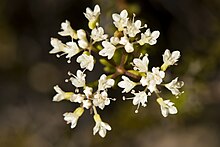Platysace commutata is a shrub that is endemic to the south-west of Western Australia. It has linear leaves and white to cream-coloured or blue flowers.
| Platysace commutata | |
|---|---|

| |
| Near Porongurup | |
| Scientific classification | |
| Kingdom: | Plantae |
| Clade: | Tracheophytes |
| Clade: | Angiosperms |
| Clade: | Eudicots |
| Clade: | Asterids |
| Order: | Apiales |
| Family: | Apiaceae |
| Genus: | Platysace |
| Species: | P. commutata
|
| Binomial name | |
| Platysace commutata | |
| Synonyms | |
| |
Description
editPlatysace commutata is a heath-like shrub with rod-like branches[2] that typically grows to a height of 10–50 cm (3.9–19.7 in).[3] Its leaves are linear, sometimes crowded, about 4–8.5 mm (0.16–0.33 in) long and often slightly twisted. The flowers are borne in umbels on a peduncle shorter than the end leaves. The 2 or 3 involucral bracts are similar to the stem leaves.[2] Flowering occurs between October and December or from January to April[3] and the fruit is spherical, nearly 2 mm (0.079 in) in diameter.[2]
Taxonomy
editThis species was first formally described in 1849 by Nikolai Turczaninow who gave it the name Trachymene commutata in the Bulletin de la Société Impériale des Naturalistes de Moscou, from specimens collected near the Swan River by James Drummond.[4][5] In 1939, Cecil Norman transferred the species to the genus Platysace as P. commutata in the Journal of Botany, British and Foreign.[6] The specific epithet (commutata) means "changed" or "altered", referring to the variable leaf forms.[7]
Distribution and habitat
editOften found among quartzite rocks on hilltops and summits, P. commutata is distributed widely but with a scattered population in the Avon Wheatbelt, Esperance Plains, Geraldton Sandplains, Jarrah Forest and Mallee bioregions of south-western Western Australia.[3]
Conservation status
editPlatysace commutata is listed as "not threatened" by the Western Australian Government Department of Biodiversity, Conservation and Attractions.[3]
References
edit- ^ "Platysace commutata". Australian Plant Census. Retrieved 14 March 2024.
- ^ a b c Bentham, George (1867). Flora Australiensis. London: Lovell Reeve & Co. p. 355. Retrieved 6 March 2024.
- ^ a b c d "Platysace commutata". FloraBase. Western Australian Government Department of Biodiversity, Conservation and Attractions.
- ^ "Trachymene commutata". APNI. Retrieved 15 March 2024.
- ^ Turczaninow, Nikolai (1849). "Decas sexta generum plantarum hucusque non descriptorum adjectis descriptionibus specierum nonnullarum". Bulletin de la Société impériale des naturalistes de Moscou. 22 (3): 30–31. Retrieved 15 March 2024.
- ^ "Platysace commutata". APNI. Retrieved 15 March 2024.
- ^ Sharr, Francis Aubi; George, Alex (2019). Western Australian Plant Names and Their Meanings (3rd ed.). Kardinya, WA: Four Gables Press. p. 167. ISBN 9780958034180.